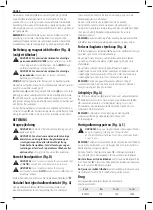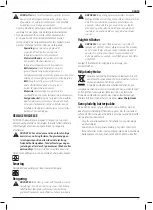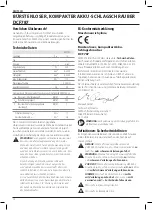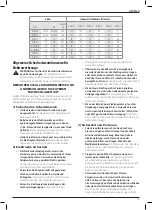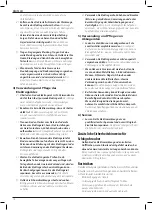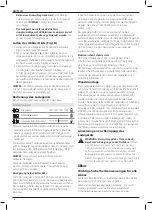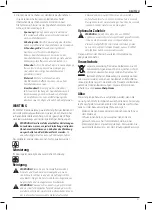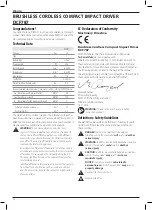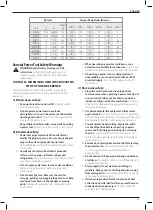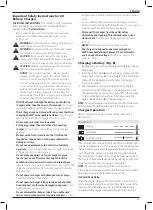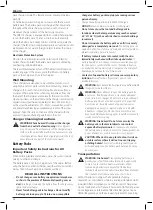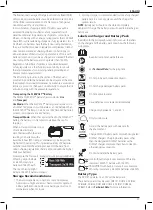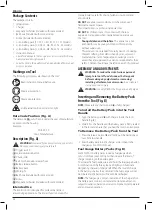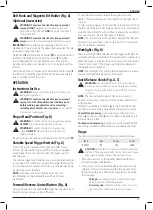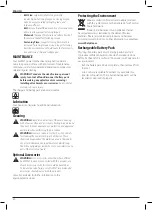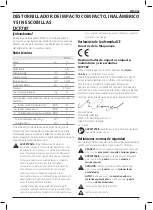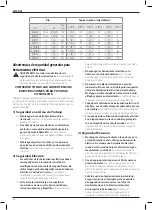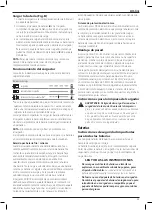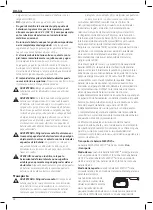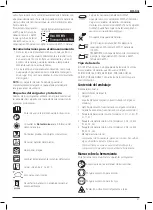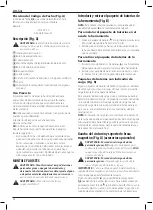
24
EnGLIsh
4) Power tool use and care
a )
Do not force the power tool. Use the correct power
tool for your application.
The correct power tool
will do the job better and safer at the rate for which it
was designed.
b )
Do not use the power tool if the switch does not turn
it on and off.
Any power tool that cannot be controlled
with the switch is dangerous and must be repaired.
c )
Disconnect the plug from the power source and/or
the battery pack from the power tool before making
any adjustments, changing accessories, or storing
power tools.
Such preventive safety measures reduce the
risk of starting the power tool accidentally.
d )
Store idle power tools out of the reach of children
and do not allow persons unfamiliar with the power
tool or these instructions to operate the power tool.
Power tools are dangerous in the hands of untrained users.
e )
Maintain power tools. Check for misalignment or
binding of moving parts, breakage of parts and any
other condition that may affect the power tool’s
operation. If damaged, have the power tool repaired
before use.
Many accidents are caused by poorly
maintained power tools.
f )
Keep cutting tools sharp and clean.
Properly
maintained cutting tools with sharp cutting edges are less
likely to bind and are easier to control.
g )
Use the power tool, accessories and tool bits etc.,
in accordance with these instructions taking into
account the working conditions and the work to be
performed.
Use of the power tool for operations different
from those intended could result in a hazardous situation.
5) Battery tool use and care
a )
Recharge only with the charger specified by the
manufacturer.
A charger that is suitable for one type
of battery pack may create a risk of fire when used with
another battery pack.
b )
Use power tools only with specifically designated
battery packs.
Use of any other battery packs may create
a risk of injury and fire.
c )
When battery pack is not in use, keep it away from
other metal objects like paper clips, coins, keys,
nails, screws or other small metal objects that can
make a connection from one terminal to another.
Shorting the battery terminals together may cause burns
or a fire.
d )
Under abusive conditions, liquid may be ejected
from the battery; avoid contact. If contact
accidentally occurs, flush with water. If liquid
contacts eyes, additionally seek medical help.
Liquid
ejected from the battery may cause irritation or burns.
6) Service
a )
Have your power tool serviced by a qualified repair
person using only identical replacement parts.
This
will ensure that the safety of the power tool is maintained.
Additional Specific Safety Rules for Impact
Drivers
•
Hold power tool by insulated gripping surfaces when
performing an operation where the fastener may
contact hidden wiring.
Fasteners contacting a “live” wire
may make exposed metal parts of the power tool “live” and
could give the operator an electric shock.
Residual Risks
In spite of the application of the relevant safety regulations
and the implementation of safety devices, certain residual risks
cannot be avoided. These are:
• Impairment of hearing.
• Risk of personal injury due to flying particles.
• Risk of burns due to accessories becoming hot
during operation.
• Risk of personal injury due to prolonged use.
Electrical Safety
The electric motor has been designed for one voltage only.
Always check that the battery pack voltage corresponds to the
voltage on the rating plate. Also make sure that the voltage of
your charger corresponds to that of your mains.
Your
D
e
WALT
charger is double insulated in
accordance with EN60335; therefore no earth wire
is required.
If the supply cord is damaged, it must be replaced by a
specially prepared cord available through the
D
e
WALT
service organisation.
Mains Plug Replacement
(U.K. & Ireland Only)
If a new mains plug needs to be fitted:
• Safely dispose of the old plug.
• Connect the brown lead to the live terminal in the plug.
• Connect the blue lead to the neutral terminal.
WARNING:
No connection is to be made to the
earth terminal.
Follow the fitting instructions supplied with good quality plugs.
Recommended fuse: 3 A.
Using an Extension Cable
An extension cord should not be used unless absolutely
necessary. Use an approved extension cable suitable for
the power input of your charger (see
Technical Data
). The
minimum conductor size is 1 mm
2
; the maximum length
is 30 m.
When using a cable reel, always unwind the cable completely.
SAVE THESE INSTRUCTIONS
Chargers
D
e
WALT
chargers require no adjustment and are designed to be
as easy as possible to operate.
Содержание DCF787
Страница 1: ...DCF787 Final page size A5 148mm x 210mm ...
Страница 3: ...1 Fig A Fig B 8 9 9 10 1 3 4 7 5 6 5 6 2 12 ...
Страница 4: ...2 Fig D Fig C 3 11 4 4 3 ...
Страница 130: ...128 ...
Страница 131: ...129 ...

